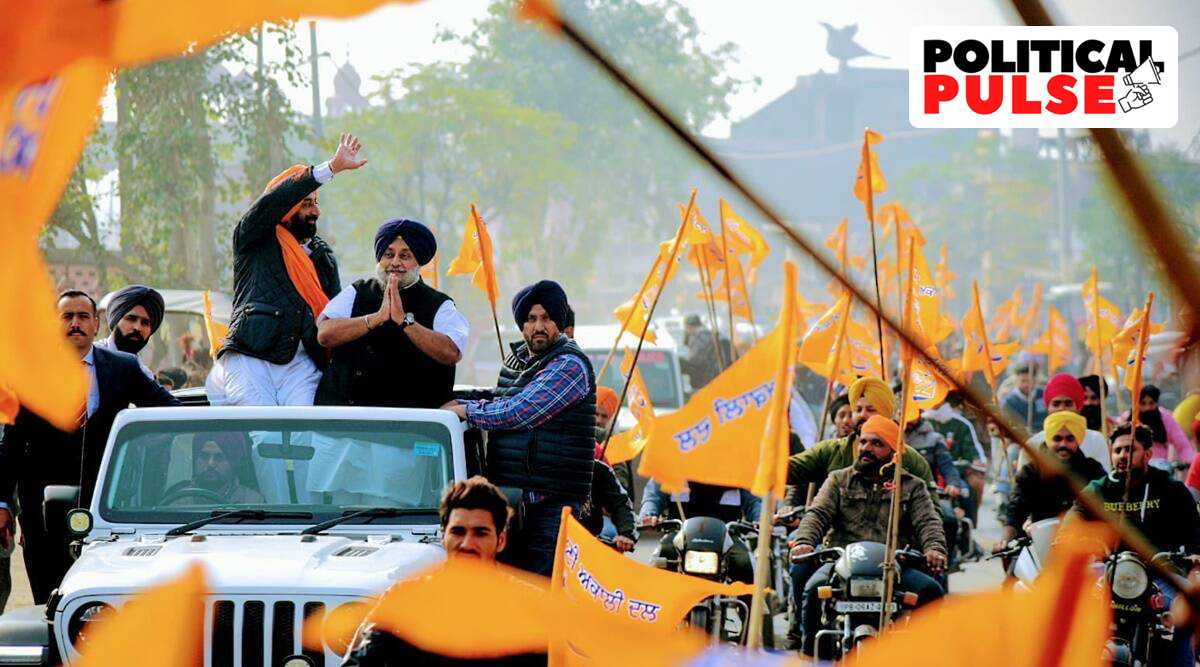 Sukhbir Badal at a public rally in Dera Baba Nanak ahead of the Punjab elections. (Photo: Twitter/Sukhbir Singh Badal)
Sukhbir Badal at a public rally in Dera Baba Nanak ahead of the Punjab elections. (Photo: Twitter/Sukhbir Singh Badal) AS IT joins the Congress and CPI to become only the third party in India to complete 100 years, the Shiromani Akali Dal is in the midst of its toughest crisis yet. It is heading into the coming Assembly elections without the BJP (a partner of SAD since its Jana Sangh days), the state is seeing a four-cornered contest after a long time, there is lingering anger against the party over corruption and drug charges, it is yet to fully shake off its association with the Centre despite resigning from the Union ministry over the contentious farm laws, and doyen Parkash Singh Badal is, at 94, a shadow of himself.
Overshadowed by Badal Sr for almost his entire political career, former deputy chief minister Sukhbir Badal is not as much credited for SAD back-to-back Assembly election wins in 2007 and 2012, as much as blamed for the debacle of last time. In the 2017 polls, SAD had finished third, behind the Congress and even the fledgling AAP.
In the latest blow to Sukhbir, his close aide Manjinder Singh Sirsa crossed over to the BJP on December 1 – becoming the latest senior leader to quit SAD.
Earlier, veteran leaders like Ranjit Singh Brahampura, Sukhdev Singh Dhindsa and the late Sewa Singh Sekhwan had left, criticising Sukhbir’s style of functioning. They formed their own outfit, which is said to be in talks with the BJP for the coming elections. On the same day as Sirsa left, Parminder Singh Brar, who headed SAD’s IT wing before joining the Congress, also joined the BJP. Brar is the grandson of late Akali leader Hari Singh Zira.
A member of the SAD Core Committee, Sirsa had been a prominent face of the party in Delhi. As president of the Delhi Sikh Gurdwara Management Committee (DSGMC), Sirsa was also a link to the farmers sitting on protest on the Capital’s borders, having supported the farm agitation and organised langar for them. (Sirsa has also quit as DSGMC chief now.)
A senior Akali leader said: This is a setback for Sukhbir Badal as the SAD chief, especially as he has been working hard to keep the flock together after earlier revolts by senior leaders.”
Another leader worried that poaching from SAD ranks seemed to be a crucial part of the BJP’s “very active” strategising for the Punjab elections. The end of the farmer agitation and an alliance with former Congress CM Amarinder Singh mean the situation is not as hopeless for the BJP as it once seemed.
In 2017, after SAD won only 15 of the 117 Assembly seats in Punjab, knives first came out for Sukhbir, with veteran leaders blaming him for “the worst ever political performance of the party”. Sukhbir also remains personally vulnerable due to the heat on his powerful brother-in-law Bikramjit Singh Majithia over alleged drug racket connections. Indicating Majithia’s hold, SAD recently held protests claiming that the Congress government was trying to “frame” him.
The Congress, which appeared to be floundering after the forced exit of Amarinder and the unending self-goals by state chief Navjot Singh Sidhu, meanwhile, seems to have gained some lost ground. Its new CM, Charanjit Singh Channi, appeals to a large section of the population as the first Dalit to head the state. Channi is also seen to be clean and an “aam aadmi”, compared to the entrenched Badals and Amarinder Singh – an image he has done well to reinforce.
The fourth contender in the poll race is Amarinder’s Punjab Lok Congress, which with the BJP can hope to make some impact.
SAD has found one ally in the Mayawati-led BSP, which still commands some support in the native state of its founder Kanshi Ram among the Dalits. As per the arrangement reached between the two parties, SAD will contest 97 seats and the BSP 20.
To woo Hindu voters, who might turn away from the party after its rift with the BJP, Sukhbir has announced there will be two deputy CMs should the SAD-BSP win — one a Hindu and the other a Dalit; the latter from the BSP.
- The Indian Express website has been rated GREEN for its credibility and trustworthiness by Newsguard, a global service that rates news sources for their journalistic standards.

